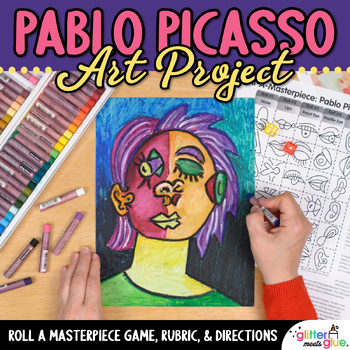Hispanic Heritage Month Activities: Pablo Picasso Art Project, Roll a Dice Game
- Zip
- Google Apps™
- Easel Activity

What educators are saying
Also included in
- Ready to teach modern art in a way that’ll keep elementary and middle school kids engaged? These 9 roll a dice drawing games based on contemporary artists will boost student confidence and creativity. Each art project comes with a self-guided PowerPoint and printable handout. Perfect art sub plans!APrice $28.79Original Price $45.00Save $16.21
- Looking to weave art history into your elementary and middle school art curriculum? These roll a dice games based on Pop Art, Modern Art, Black Artists, and various cultures will ignite your art lessons. Each engaging art project makes for great art sub plans because they include art worksheets, artPrice $100.79Original Price $175.00Save $74.21
Description
Ready to liven up your elementary art curriculum with a fun Hispanic Heritage Month activity? This Pablo Picasso art project will boost confidence and creativity. Kids will be amazed by his abstract Cubist portraits. Moreover, they’ll connect with his personal story about discovering Cubism.
And, it’ll help time-starved teachers like you create lesson plans based on modern abstract portrait artists like Pablo Picasso.
During this lesson on Picasso your class will learn about Cubism, an art style with expressive colors and fragmented shapes. And, they’ll learn about his Blue Period and Rose Period while playing a fun roll a Picasso game. Students will create an abstract portrait with a two-sided face using oil pastels, the step-by-step guide, and PowerPoint.
Plan lessons for students about contemporary artists and art appreciation in a way that excites them. Finally feel confident in your art curriculum and be organized and prepared to teach art!
WHAT'S INCLUDED
Can I be honest with you? Art history can sometimes be boring for kids. There, I said it. Teaching about artists and cultures doesn’t have to be a snoozer, though!
I’ve designed 3 different ways for students to attempt this Picasso project. All will engage kids to create! Choose which way works best for your classes:
- Roll a Picasso game to add randomness to your student’s artwork
- “You Pick” art worksheet for kids to choose their own elements
- Digital spinner wheels, so kids can randomly pick elements and you can integrate technology in the art room
- Printable dice template in case you have no dice
- Step-by-step picture directions to guide students through the art process
- Drawing practice worksheet, for kids who want to sketch out their ideas
- Pablo Picasso Artist biography about the life and work of this French painter, so you don’t need to research
- “Big Ideas” reflection worksheet where students write about their art process
- Self-assessment worksheet so kids can think about how they performed during the project
- Art grading rubric which assesses expectations, craftsmanship, work habits, creativity, and clean-up
- 8 “I CAN” Statements aligned to the Studio Habits of Mind to use during instruction or post on your bulletin board
- 4 Art exit tickets with quick, thought-provoking prompts
- Art history coloring pages to keep kids inspired by Pablo Picasso’s artwork outside of the art room
YOU WILL RECEIVE
- 1 Non-Editable Printable PDF (Pablo Picasso Art Project)
- 1 Non-Editable PowerPoint
- 5 Digital Spinner Videos (downloadable, and links to them on Google Slides and YouTube)
- Paperless Google Drive Digital Resource
WHY YOU’LL LOVE IT
⭐️⭐️⭐️⭐️⭐️
My students absolutely loved this activity and the pictures they created were so original and creative. I'm so glad I purchased it. It's easy to use, very little prep, very little instruction need and a whole lot of fun. Thanks for such a great activity......I can't wait to use it next year.
⭐️⭐️⭐️⭐️⭐️
This was such a fun and informative activity to introduce my students to Pablo Picasso. My class really enjoyed working with pastels and rolling the die to see what they had to draw. The students' pictures turned out great. So much fun!
⭐️⭐️⭐️⭐️⭐️
This was a fun activity to accompany a study of Picasso. I gave my students the option of using dice or choosing which features they wanted to use as inspiration. It was particularly good for my students who have trouble deciding where to start. The end results were fabulous!
YOU MIGHT ALSO LIKE
- Henri Matisse Art Project
- Roy Lichtenstein Art Project
- Romero Britto Owl Art Project
Created by Amie Bentley, © Glitter Meets Glue Designs, LLC








